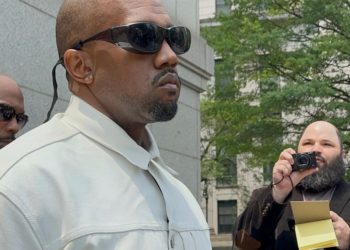At the foot of the Williamsburg Bridge in Manhattan, a new arts venue dedicated to video, sound and performance in the cavernous interiors of an office building that never found its stride after it opened during the pandemic.
The veteran museum director Joseph C. Thompson and the financier Robert Rosenkranz are planning to rechristen a 42,000-square-foot space in the building, on the Lower East Side, as Canyon, a nonprofit organization seeking to upend the traditional museum experience and attract younger audiences.
“The galleries will be equipped more like living rooms than a typical white box,” said Thompson, who led the Massachusetts Museum of Contemporary Art for more than three decades.
The project was announced on Friday morning. The firm New Affiliates Architecture will design an adaptive reuse of the space and has preliminary plans to install a restaurant, cafe and performance hall, as well as bars serving alcohol and food throughout. About half of the square footage will be reserved for galleries built with the latest audiovisual technology, a project being overseen by the art conservator Cass Fino-Radin. The location, at 200 Broome Street, puts the organization in proximity to a bustling scene for young galleries and attractions like Essex Market and the Tenement Museum.
Rosenkranz, whose foundation now owns the building, described the project as “venture philanthropy,” saying that he planned to cover the initial construction costs of nearly $10 million while raising funds to offset a projected annual budget of about the same amount. Canyon plans on charging $30 for admission, but will have free admission for school groups and through public libraries.
Rosenkranz said that creating a new venue — especially one dedicated to video, a medium that museums have generally struggled to present — would incur some risks. “But that gives philanthropists an opportunity to bring something to our society that didn’t exist before,” he explained.
For the last five years, Rosenkranz and his team have searched for an ideal venue to host the arts organization after abandoning plans to build at Pier 57 off the west side of Manhattan. But the location on Broome Street had enticed him thanks to its blocklong atrium, complete with 60-foot-tall ceilings and retail spaces that could be converted into galleries.
Ian Cheng, a local artist whose virtual creations use artificial intelligence and other programs to question life in the digital age, has advised on the project and coined the institution’s name to reflect the space’s high ceilings and location in New York: a city whose skyscrapers often make its streets feel like stepping into the middle of a canyon.
Cheng said in an interview that the art world had become more homogenous in recent years as commissions for experimental work have decreased and the market has become fixated on painting. He said the venue “would have to answer new questions for the younger audience interested in art, who maybe only experience it through social media.”
Thompson says that he thinks of it as making quality-of-life adjustments to the museum experience. Galleries would have time bars over the doors, telling viewers if a video was in progress and when it would end; visitors would be able to take their food and drinks into the galleries. Canyon also plans to be open from 2 p.m. to 10 p.m., catering to the schedules of working people and what Thompson called “the circadian rhythm of the Lower East Side.”
Rosenkranz, who also serves as a vice president on the board of the Whitney Museum, said that he purposefully did not want to describe Canyon as a museum despite it retaining many of the same qualities. It’s a difficult time for the museum industry, which has not economically recovered from the Covid pandemic as quickly as other entertainment forms like theater and sports. Rising overhead costs and plateauing attendance figures have left some institutions in a financial bind.
But Rosenkranz sees a path forward. “I certainly hope this is more sustainable,” he said, pointing out that most video art does not include shipping and insurance costs. “I do see it as potentially having an appeal to a broader audience than the audience that typically goes to museums. I see it as a date-night place.”
There is still a lot of work ahead for developers within the next year, including hiring a staff of about 30 employees. (The institution plans to mostly rely on guest curators for programming.) Rosenkranz said that he hoped the inaugural program would include exhibitions from the Japanese artist Ryoji Ikeda, the South African artist William Kentridge and the British artist Isaac Julien, among others.
“Canyon reflects my belief that cultural institutions must evolve to meet the intellectual and sensory lives of contemporary audiences,” Rosenkranz said. “The artists working in time-based media today are grappling with everything from artificial intelligence and facial recognition to climate anxiety and cultural memory. This is not just a genre, but a frontline of cultural expression.”
Zachary Small is a Times reporter writing about the art world’s relationship to money, politics and technology.
The post Can Video Art Bring Young Audiences to Galleries? A New Venue Hopes So. appeared first on New York Times.




